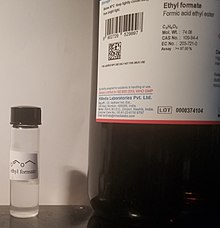| |||

| |||
| Names | |||
|---|---|---|---|
| Preferred IUPAC name
Ethyl formate | |||
| Systematic IUPAC name
Ethyl methanoate | |||
| Identifiers | |||
3D model (JSmol)
|
|||
| 906769 | |||
| ChEBI | |||
| ChEMBL | |||
| ChemSpider | |||
| ECHA InfoCard | 100.003.384 | ||
| EC Number |
| ||
PubChem CID
|
|||
| RTECS number |
| ||
| UNII | |||
| UN number | 1190 | ||
CompTox Dashboard (EPA)
|
|||
| |||
| |||
| Properties | |||
| C3H6O2 | |||
| Molar mass | 74.079 g·mol−1 | ||
| Appearance | Colorless liquid[1] | ||
| Odor | fruity[1] | ||
| Density | 0.917 g/cm3 | ||
| Melting point | −80 °C; −112 °F; 193 K | ||
| Boiling point | 54.0 °C (129.2 °F; 327.1 K) | ||
| 9% (17.78°C)[1] | |||
| Vapor pressure | 200 mmHg (20°C)[1] | ||
| -43.00·10−6 cm3/mol | |||
| Hazards | |||
| Flash point | −20 °C; −4 °F; 253 K[1] | ||
| Explosive limits | 2.8% - 16.0%[1] | ||
| Lethal dose or concentration (LD, LC): | |||
LD50 (median dose)
|
1850 mg/kg (rat, oral) 1110 mg/kg (guinea pig, oral) 2075 mg/kg (rabbit, oral)[2] | ||
LCLo (lowest published)
|
10,000 ppm (cat, 1.5 hr) 8000 ppm (rat, 4 hr)[2] | ||
| NIOSH (US health exposure limits): | |||
PEL (Permissible)
|
TWA 100 ppm (300 mg/m3)[1] | ||
REL (Recommended)
|
TWA 100 ppm (300 mg/m3)[1] | ||
IDLH (Immediate danger)
|
1500 ppm[1] | ||
Except where otherwise noted, data are given for materials in their standard state (at 25 °C [77 °F], 100 kPa).
| |||
Ethyl formate is an ester formed when ethanol (an alcohol) reacts with formic acid (a carboxylic acid). Ethyl formate has the characteristic smell of rum and is partially responsible for the flavor of raspberries,[3] occurring naturally in some plant oils, fruits, and juices. Ethyl formate does not occur naturally in the animal kingdom.[4]
- ^ a b c d e f g h i NIOSH Pocket Guide to Chemical Hazards. "#0278". National Institute for Occupational Safety and Health (NIOSH).
- ^ a b "Ethyl formate". Immediately Dangerous to Life or Health Concentrations (IDLH). National Institute for Occupational Safety and Health (NIOSH).
- ^ Sample, Ian (21 April 2009). "Galaxy's centre tastes of raspberries and smells of rum, say astronomers". The Guardian. Archived from the original on 6 July 2017. Retrieved 2009-04-21.
- ^ "eCFR :: 21 CFR 184.1295 -- Ethyl formate". 2024-02-22. Archived from the original on 2024-02-22. Retrieved 2024-02-22.

